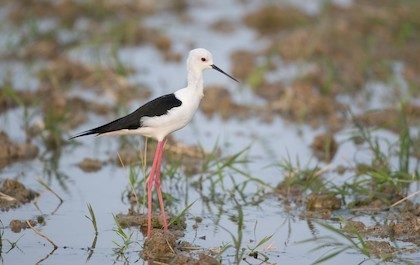Birdfinding.info ⇒ Common in many parts of its large range, mainly along coastal plains and interior basins with salt pans and similar types of ponds and impoundments. Regions where it is especially numerous and conspicuous include: all around the Mediterranean, Senegambia, southern Africa, Turkey, most of the Indian subcontinent, generally along southern coasts of Asia from the Persian Gulf to the Gulf of Siam, and Taiwan.
Black-winged Stilt
Himantopus himantopus
Eurasia and Africa, in ponds, lagoons, saltpans, and marshes with expanses of shallow water.
In Europe, breeds locally from the Netherlands, Czechia, Hungary, and Romania south to the Mediterranean and east across the Ukraine and Turkey. Winters mainly in the Mediterranean zone from the Iberian Peninsula and southern France to Turkey.
In spring, overshooting migrants regularly wander north to the British Isles, Germany, Denmark, southern Sweden, Poland, and Belarus; and exceptionally to Iceland, Finland, and the Baltics. In summer and fall, much smaller numbers wander to northern and eastern Europe.
In Macaronesia, breeds locally in the Canary Islands (Fuerteventura and Lanzarote) and Cape Verde (Sal and Boa Vista), and irregularly visits other islands in these archipelagos. Vagrant to the Azores and Madeira, exceptionally west to Gaudeloupe in the Lesser Antilles.
In Africa, resident essentially throughout, wherever suitable habitat exists: all of sub-Saharan Africa plus the Nile Valley and northern coasts. Also a localized resident on Madagascar. Numbers across the region presumably swell with European migrants during the northern winter, although this is difficult to determine.
In Asia, breeds across a wide band of the temperate zone from the southern Ukraine east across southern Russia, the Caucasus, Turkmenistan, Uzbekistan, Kazakhstan, and Mongolia to eastern China and the western coast of the Korean Peninsula, with a small outpost in central Honshu.
In spring, overshooting migrants regularly wander north and east to southeastern Russia and throughout Japan. Exceptional overshooting vagrants have reached the Aleutian and Pribilof Islands, Kure, and Midway on a few occasions (six records through 2020, all in spring).
Also breeds locally across southern Asia from Israel, Syria, Iraq, and Arabian Peninsula coasts east across Iran, the Indian subcontinent and Southeast Asia to the Malay Peninsula, southern China, Taiwan, and Luzon.

Black-winged Stilt, female who overshot the breeding grounds and landed in Iceland. (Síki í Garði, Suðurnes, Iceland; April 21, 2017.) © Yann Kolbeinsson
In winter, withdraws from the northern breeding grounds and becomes more numerous and widespread across southern Asia. Regularly winters south to Socotra Island, the northern coast of Borneo, the central Philippines, Palau, and the Marianas. Vagrants have reached the Seychelles, Diego Garcia, and the Marshall Islands.
Identification
Distinctive and unlikely to be mistaken for anything except another stilt: a large shorebird with a long neck, a straight or slightly upcurved, thin, black bill, extraordinarily long pink legs, and crisply contrasting black-and-white plumage.
Shows significant plumage variation. The typical adult has black wings only; the rest of its plumage, including all of the head and neck, is completely white or whitish. However, a significant minority has some black or blackish feathering over some portion of the head or neck. This varies from localized blackish shadows to a full black helmet and much of the neck.
Males typically appear jet-black on the upperparts, or sometimes show a greenish sheen.
When seen at close range, females and older immatures typically appear dark-brown instead of jet-black on the scapulars (i.e., most of the “back”).

Black-winged Stilt, male with typical plumage. (Nxamaseri Lodge, Botswana; November 24, 2005.) © Bruce Ward-Smith
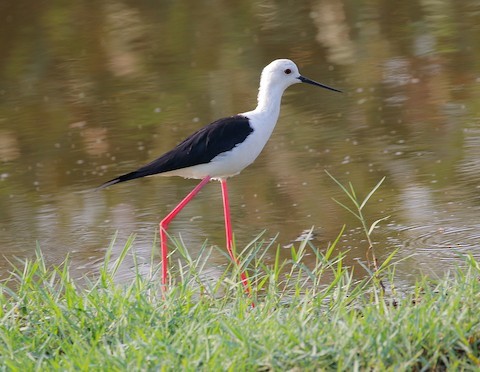
Black-winged Stilt, male with typical plumage. (Pulau Burung Landfill, Pulau Pinang, Malaysia; April 15, 2019.) © Neoh Hor Kee
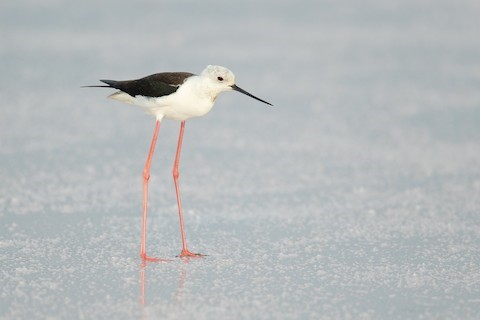
Black-winged Stilt, female with typical plumage. (Pak Tha Le, Phetchaburi, Thailand; January 1, 2020.) © Dorian Anderson
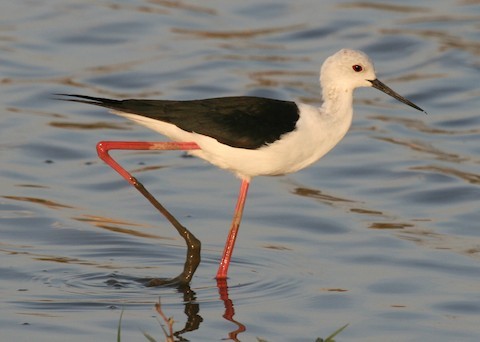
Black-winged Stilt, male with typical plumage. (Ndutu Safari Lodge, Ngorongoro Conservation Area, Tanzania; October 10, 2009.) © Jordan Roderick
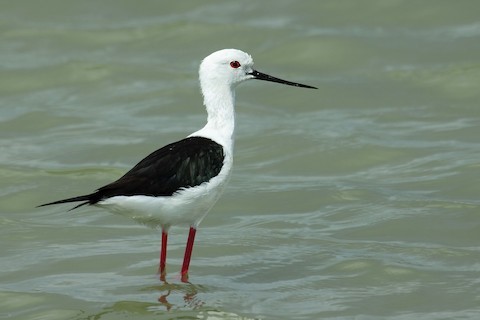
Black-winged Stilt, male with typical plumage. (Pinheiro Torto, Estuário do Sado Nature Reserve, Setúbal, Portugal; May 20, 2012.) © Dorian Anderson
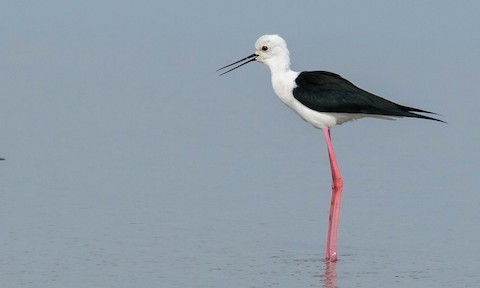
Black-winged Stilt, male with typical plumage. (Pak Tha Le, Phetchaburi, Thailand; November 7, 2018.) © Paul Fenwick

Black-winged Stilt, male with typical plumage. (Lac Antsirabe, Toliara, Madagascar; April 17, 2015.) © Zak Pohlen
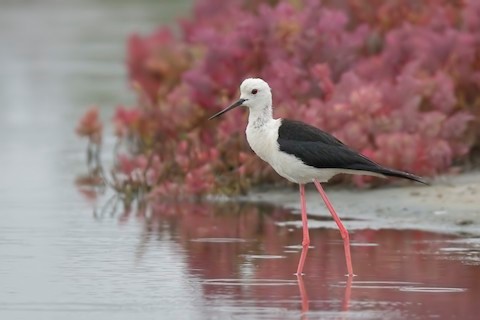
Black-winged Stilt, male with typical plumage. (Khlong Tamru, Chon Buri, Thailand; May 13, 2019.) © Sharif Uddin
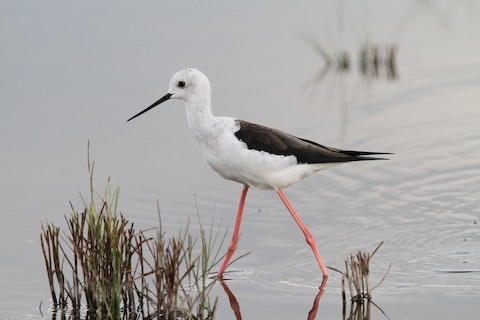
Black-winged Stilt, female with typical plumage. (S’Albufera, Mallorca, Spain; September 30, 2010.) © Christoph Moning

Black-winged Stilt, female with typical plumage. (Flaming Pools, HaDarom, Israel; March 28, 2018.) © Marky Mutchler
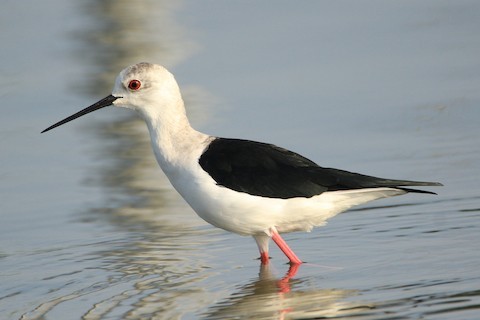
Black-winged Stilt, male with typical plumage. (Kumbhargaon Bird Sanctuary, Pune, Maharashtra, India; October 16, 2016.) © Aravind Amirtharaj
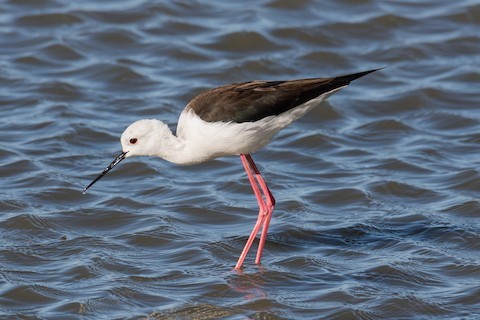
Black-winged Stilt, female with typical plumage. (S’Albufera, Mallorca, Spain; February 14, 2020.) © Toni Pons

Black-winged Stilt, male and female with typical plumage. (Batu Gajah, Perak, Malaysia; January 10, 2018.) © Zhong Ying Koay
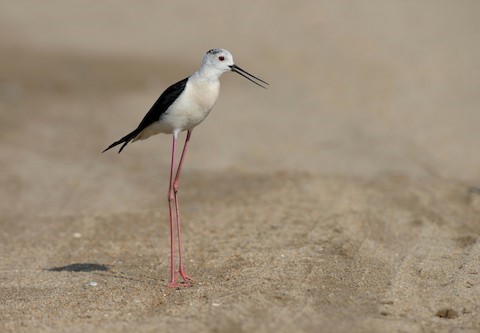
Black-winged Stilt, male with blackish cap. (Kesan, Edirne, Turkey; June 27, 2016.) © Pavel Štěpánek

Black-winged Stilt, male with blackish smudging around eyes and mid-crown. (Uytkerkse Polder, Vlaamse Gewest, Belgium; April 23, 2014.) © Frans Vandewalle
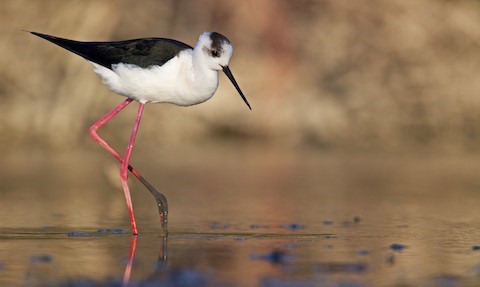
Black-winged Stilt, male with black around eyes and mid-crown. (Pont de Gau, Camargue, France; April 9, 2014.) © Ian Davies
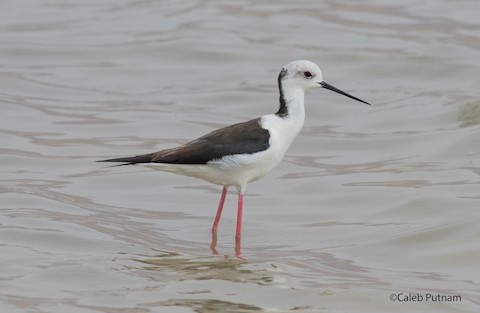
Black-winged Stilt, female with black on back of neck only—possibly indistinguishable from Australasian Pied Stilt, which would be highly unlikely to occur in this location. (Flamingo Pools, HaDarom, Israel; March 24, 2016.) © Caleb Putnam
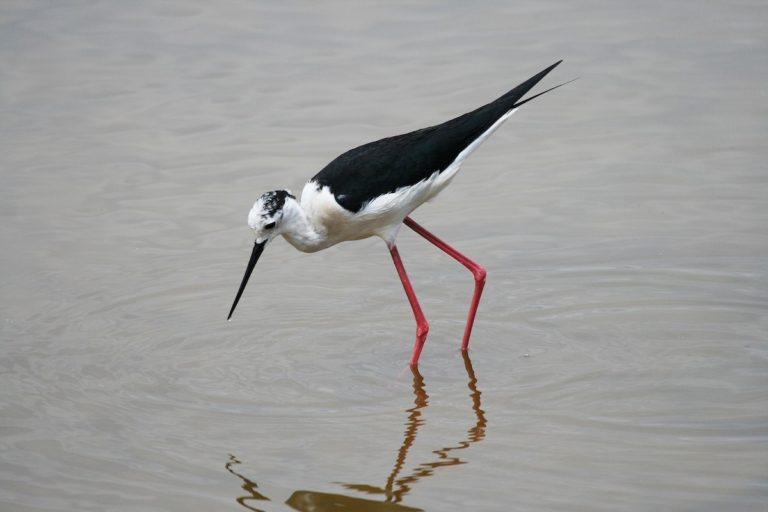
Black-winged Stilt, male with black on hindcrown and back of the neck. (Ebro Delta, Tarragona, Cataluña, Spain; April 9, 2014.) © Eduardo Soler
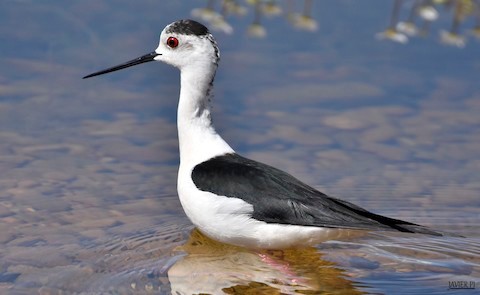
Black-winged Stilt, male with black cap and some black on the back of the neck. (Gravera, León, Castilla y León, Spain; May 12, 2019.) © Javier Pi Vallina
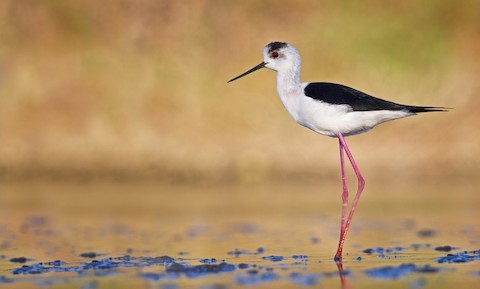
Black-winged Stilt, male with black cap. (Pont de Gau, Camargue, France; April 9, 2014.) © Ian Davies

Black-winged Stilt, male with black cap. (Pont de Gau, Camargue, France; April 9, 2014.) © Ian Davies
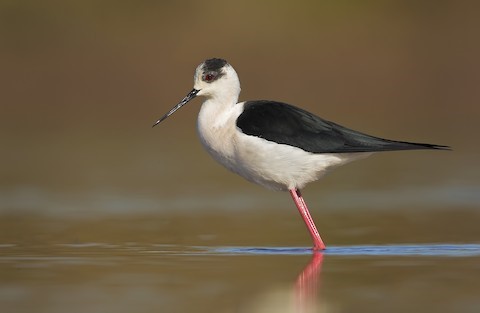
Black-winged Stilt, male with black cap and around the eyes. (Pantani dell’Inferno, Caprolace, Lazio, Italy; March 25, 2016.) © Marco Valentini
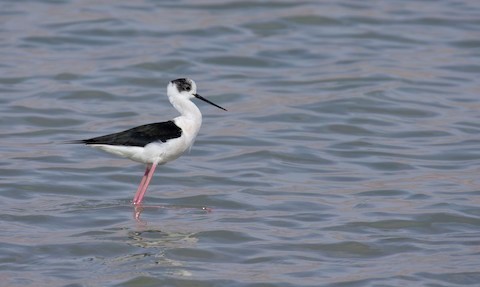
Black-winged Stilt, male with black around eyes and mid-crown. (Flamingo Pools, HaDarom, Israel; March 28, 2018.) © Marky Mutchler
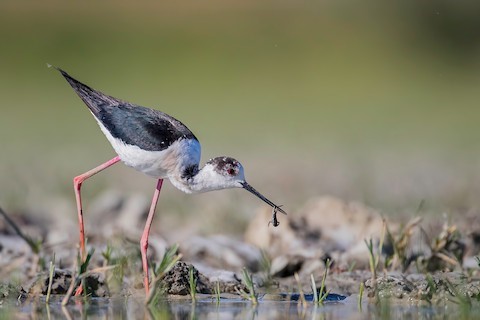
Black-winged Stilt, female with black on the crown and back of the neck. (Ultima Fontiera, Tulcea, Romania; May 31, 2018.) © Pascal De Munck

Black-winged Stilt, male with black cap. (Axios Delta, Greece; April 4, 2018.) © Theodosis Mamais
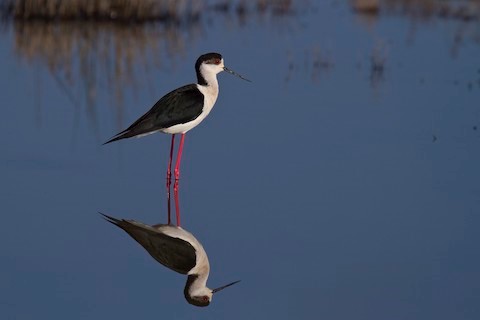
Black-winged Stilt, male with black crown and back of the neck. (Gialova, Peloponnisos, Greece; April 17, 2015.) © Henrik Bringsøe
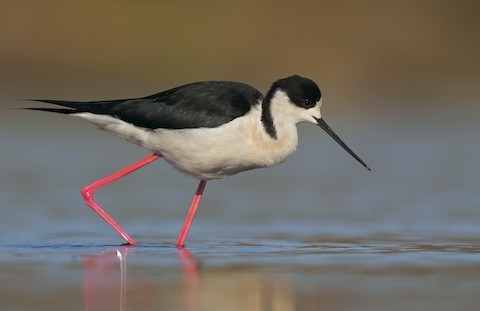
Black-winged Stilt, male with black helmet and on the back of the neck—note that this is similar to Black-necked Stilt’s typical plumage, but not identical as it lacks a white spot above the eye. (Pantani dell’Inferno, Caprolace, Lazio, Italy; March 25, 2016.) © Marco Valentini

Black-winged Stilt, male with black on crown and the back of the neck. (Delta de l’Ebre National Park, Tarragona, Cataluña, Spain; March 24, 2019.) © Jesus Barreda

Black-winged Stilt, male with blackish helmet and black on the back of the neck. (Pantani dell’Inferno, Caprolace, Lazio, Italy; March 22, 2016.) © Marco Valentini
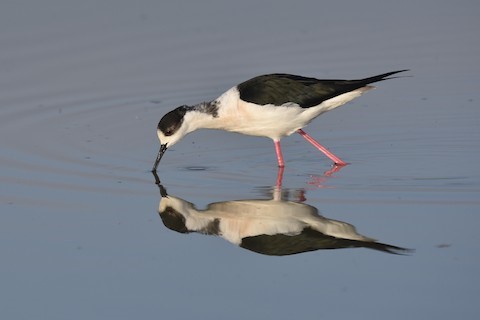
Black-winged Stilt, male with black helmet and some black on the back of the neck. (Fuente de Piedra, Málaga, Andalucía, Spain; March 15, 2019.) © Santiago Caballero Carrera

Black-winged Stilt, male with black helmet and on the back of the neck. (Pantani dell’Inferno, Caprolace, Lazio, Italy; March 25, 2016.) © Marco Valentini
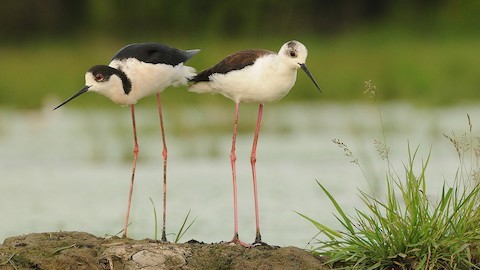
Black-winged Stilt, pair, male with black helmet and on the back of the neck, female with more typical plumage. (Hortobágyi National Park, Hungary; May 2, 2014.) © Jan Svetlik
Juveniles are less crisply marked than other age classes, usually blackish around the eyes and on the crown, and smudgy elsewhere on the head and neck.
Their dark upperparts are variably browner and paler than on adults, with initial pale fringes on the fresh feathers making them appear scaly.
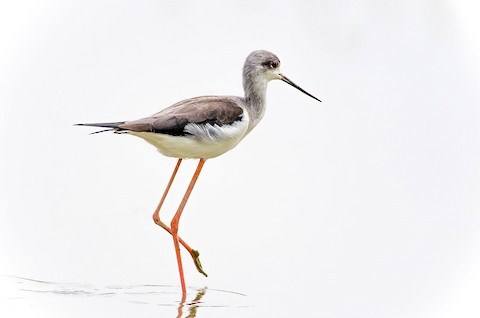
Black-winged Stilt, juvenile. (Long Valley, Hong Kong; November 2, 2014.) © John Clough

Black-winged Stilt, juvenile. (S’Albufera, Mallorca, Spain; September 30, 2010.) © Christoph Moning
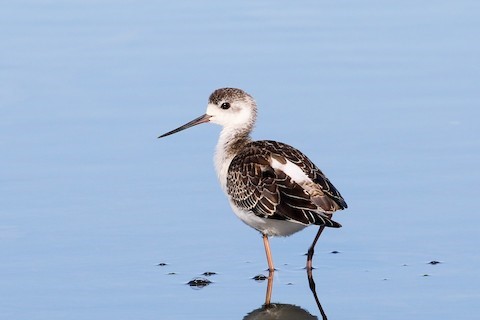
Black-winged Stilt, juvenile. (Salin de Giraud, Provence, France; September 12, 2019.) © David Blue
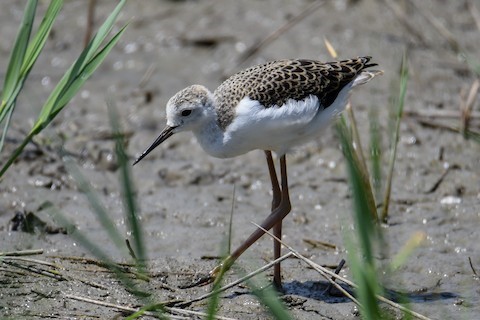
Black-winged Stilt, juvenile. (Centre de Découverte du Scamandre, Petite Camargue, Languedoc-Roussillon, France; September 12, 2019.) © Maryse Neukomm
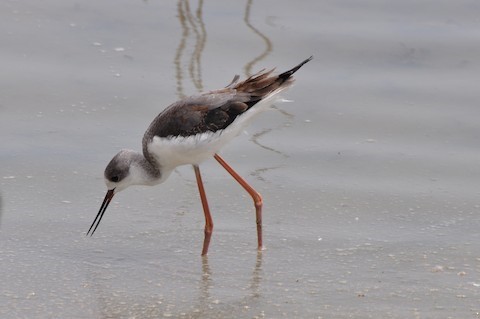
Black-winged Stilt, juvenile. (Salinas de San Pedro, Murcia, Spain; April 17, 2015.) © Raymond Marsh
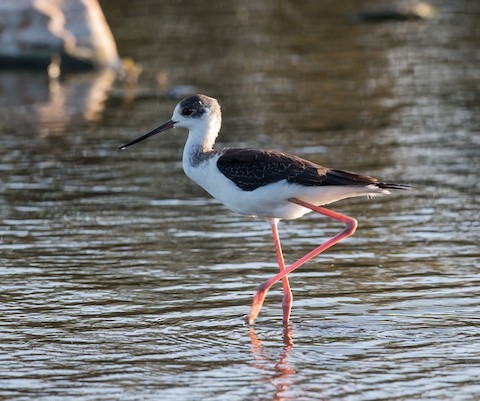
Black-winged Stilt, juvenile. (Nanhui Dongtan, Shanghai, China; September 14, 2017.) © Kai Pflug
Older immatures show a consistent pattern: a dark-brown or blackish helmet (around the eyes and the mid-crown) and a smudgy brownish wash from the hindcrown down the back of the neck.
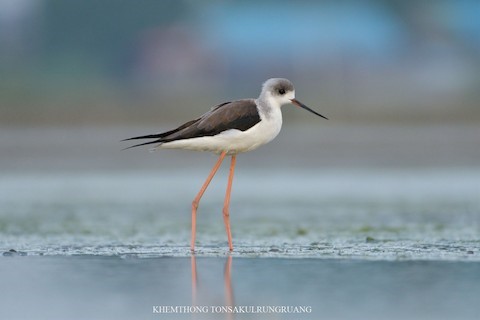
Black-winged Stilt, immature showing typical pattern. (Khok Kham, Samut Sakhon, Thailand; November 28, 2017.) © Khemthong Tonsakulrungruang
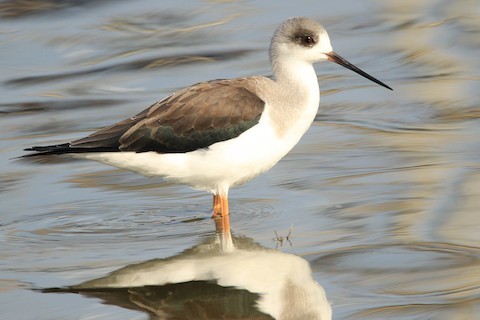
Black-winged Stilt, immature showing typical pattern. (Kumbhargaon Bird Sanctuary, Pune, Maharashtra, India; October 16, 2016.) © Aravind Amirtharaj
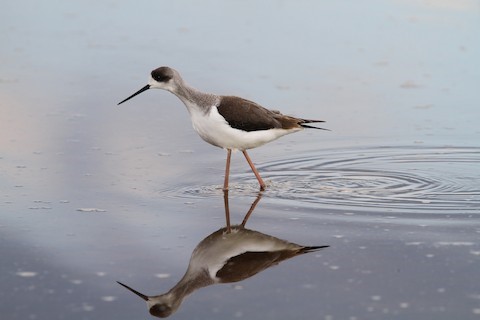
Black-winged Stilt, immature showing typical pattern. (S’Albufera, Mallorca, Spain; September 30, 2010.) © Christoph Moning
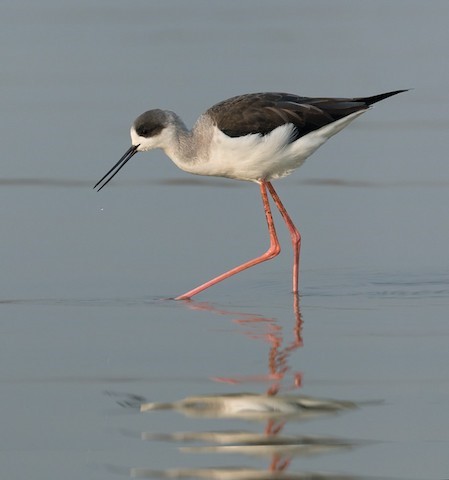
Black-winged Stilt, immature showing typical pattern. (Soorwal Dam, Sawai Madhopur, Rajasthan, India; January 1, 2016.) © Lars Petersson

Black-winged Stilt, female. (Danube Delta Biosphere Reserve, Tulcea, Romania; May 23, 2015.) © Pavel Štěpánek
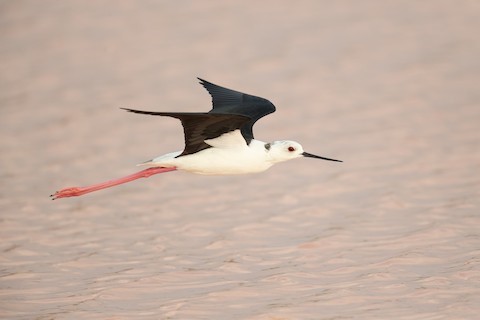
Black-winged Stilt, showing mostly black underwing with partly white lining. (Pak Tha Le, Phetchaburi, Thailand; January 1, 2020.) © Dorian Anderson
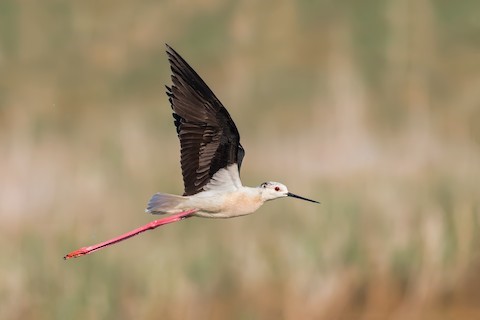
Black-winged Stilt, showing mostly black underwing with partly white lining. (Ebro Delta, Tarragona, Cataluña, Spain; June 18, 2015.) © Ivan Sjögren
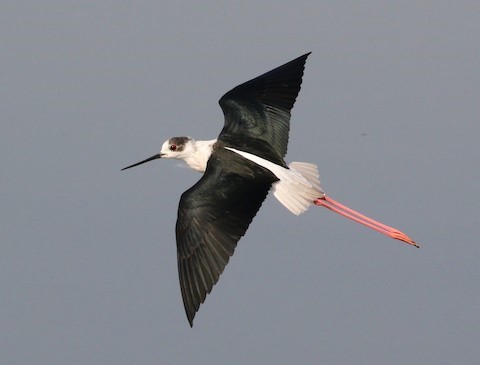
Black-winged Stilt, male with blackish cap. (Paranaque, Manila, Philippines; March 11, 2019.) © Tom Benson
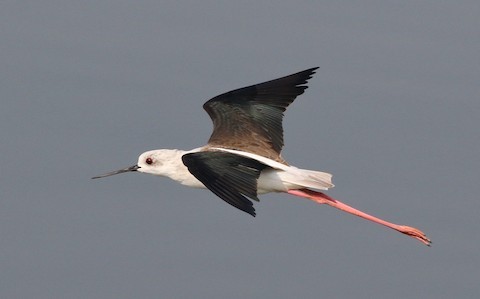
Black-winged Stilt, female. (Paranaque, Manila, Philippines; March 11, 2019.) © Tom Benson
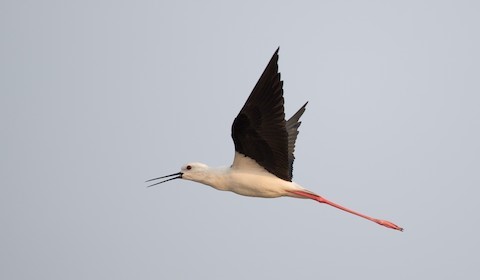
Black-winged Stilt, showing mostly black underwing with partly white lining. (Pak Tha Le, Phetchaburi, Thailand; February 20, 2017.) © Ian Davies
Cf. Pied Stilt. Black-winged and Pied Stilts overlap regularly in the Philippines, less so in Malaysia and western Indonesia, and presumably elsewhere due to vagrancy. They are often considered conspecific. However, their vocalizations seem to differ consistently and most if not all adults are readily assignable to one or the other, so recognition as separate species seems justified.

Black-winged Stilt, female with black on back of neck only—possibly indistinguishable from Australasian Pied Stilt, which would be highly unlikely to occur in this location. (Flamingo Pools, HaDarom, Israel; March 24, 2016.) © Caleb Putnam
Their plumages despite the fact that Black-winged is highly variable. Typical adult Black-winged has black wings only; the head and neck are completely white. However, many Black-winged also have some black on the head or neck. The location and amount vary—some individuals have extensive black on the head and neck. In contrast, adult Pied Stilts are almost invariable: the hindcrown and nape are black and the rest of the head and neck are white. A few Pied Stilts have more extensive black on the neck, extending onto the back. Presumably, given their extensive variability, a few Black-winged Stilts likely have the typical Pied pattern.
Immatures are much less distinctive, and there may be no reliable way to distinguish them. Both have the same basic pattern as adult Black-winged but with variable amounts of dark shading on the head and neck. They are especially confusing because immature Black-winged is typically darker than both adult Black-winged and immature Pied, whereas immature Pied is typically paler than adult Pied—so the immature plumages overlap broadly.
Pied has a smoother, deeper, more nasal voice compared to the sharp, squeaky Black-winged.
Cf. Black-necked Stilt. In their typical plumages, Black-winged and Black-necked Stilts are readily distinguishable. However, Black-winged is highly variable and a sizeable minority of individuals have some amount of black on the head and the back of the neck. A small minority of these closely resemble Black-necked Stilt. The diagnostic difference is that Black-necked has a white patch over the eye (usually enclosed by black, although in a few individuals the white connects to the white of the forehead).

Black-winged Stilt, male with black helmet and on the back of the neck—note that this is similar to Black-necked Stilt’s typical plumage, but not identical as it lacks a white spot above the eye. (Pantani dell’Inferno, Caprolace, Lazio, Italy; March 25, 2016.) © Marco Valentini
Notes
Monotypic species. Often considered conspecific with Pied Stilt (H. leucocephalus) of Australasia, and sometimes also together with Black-necked and White-backed Stilts (H. mexicanus and melanurus) of the Americas—in all cases, known collectively as either Black-winged or Pied Stilt (H. himantopus).
References
BirdLife International. 2019. Himantopus himantopus (amended version of 2016 assessment). The IUCN Red List of Threatened Species 2019: e.T22727969A155440465. https://dx.doi.org/10.2305/IUCN.UK.2019-3.RLTS.T22727969A155440465.en. (Accessed October 28, 2020.)
Brazil, M. 2009. Birds of East Asia. Princeton University Press.
eBird. 2020. eBird: An online database of bird distribution and abundance. Cornell Lab of Ornithology, Ithaca, N.Y. http://www.ebird.org. (Accessed October 28, 2020.)
Garcia-del-Rey, E. 2011. Field Guide to the Birds of Macaronesia: Azores, Madeira, Canary Islands, Cape Verde. Lynx Editions, Barcelona.
Hayman, P., J. Marchant, and T. Prater. 2009. Shorebirds: An Identification Guide. Houghton Mifflin, Boston.
Hollom, P.A.D., R.F. Porter, S. Christensen, and I. Willis. 1988. Birds of the Middle East and North Africa. T & AD Poyser, Calton, England.
Howell, S.N.G., I. Lewington, and W. Russell. 2014. Rare Birds of North America. Princeton University Press.
Kirwan, G.M., A. Levesque, M. Oberle, and C.J. Sharpe. 2019. Birds of the West Indies. Lynx Edicions, Barcelona.
Marchant, J., T. Prater, and P. Hayman. 1986. Shorebirds: An Identification Guide to the Waders of the World. Houghton Mifflin, Boston.
Mullarney, K., L. Svensson, D. Zetterström, and P.J. Grant. 1999. Birds of Europe. Princeton University Press.
Pyle, R.L., and P. Pyle. 2017. The Birds of the Hawaiian Islands: Occurrence, History, Distribution, and Status. Version 2 (January 1, 2017). http://hbs.bishopmuseum.org/birds/rlp-monograph/. B.P. Bishop Museum, Honolulu, Hawaii.
Robson, C. 2002. Birds of Thailand. Princeton University Press.
Sinclair, I., P. Hockey, W. Tarboton, and P. Ryan. 2011. Birds of Southern Africa (Fourth Edition). Random House Struik (Pty) Ltd. Cape Town, South Africa.
van Perlo, B. 1999. Birds of Southern Africa. Princeton University Press.
van Perlo, B. 2002. Birds of Western and Central Africa. Princeton University Press.
Xeno-Canto. 2020. Black-necked Stilt – Himantopus himantopus. https://www.xeno-canto.org/species/Himantopus-himantopus. (Accessed October 28, 2020.)
